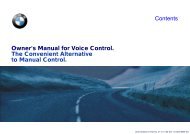Owner's Manual for the vehicle. With a quick reference ... - E38.org
Owner's Manual for the vehicle. With a quick reference ... - E38.org
Owner's Manual for the vehicle. With a quick reference ... - E38.org
You also want an ePaper? Increase the reach of your titles
YUMPU automatically turns print PDFs into web optimized ePapers that Google loves.
Tire replacement<br />
Tire rotation<br />
133n<br />
To maintain good handling and <strong>vehicle</strong><br />
response, use only tires of a single<br />
tread configuration from a single manufacturer.<br />
BMW tests and approves<br />
wheel/tire combinations. Refer to<br />
page 136.<br />
Do not use retreaded tires, since<br />
driving safety may be impaired by<br />
<strong>the</strong>ir use. This is due to <strong>the</strong> possible<br />
variations in casing structures and, in<br />
some cases, to <strong>the</strong>ir extreme age,<br />
which can lead to a decrease in <strong>the</strong>ir<br />
durability.<<br />
Tire age<br />
The date on which <strong>the</strong> tire was manufactured<br />
is indicated by <strong>the</strong> code on <strong>the</strong><br />
sidewall:<br />
DOT ... 178 means that <strong>the</strong> tires were<br />
manufactured in <strong>the</strong> 17th week of 1998.<br />
BMW recommends <strong>the</strong> replacement of<br />
all tires when <strong>the</strong> tires are no more than<br />
6 years old, even if a tire life of 10 years<br />
is possible.<br />
Spare tires over 6 years old should be<br />
used only in case of emergency. Such a<br />
tire should be replaced by a new tire<br />
immediately, and should not be<br />
mounted toge<strong>the</strong>r with new tires.<br />
Between <strong>the</strong> axles<br />
The tread wear patterns at <strong>the</strong> front end<br />
differ from those at <strong>the</strong> rear - <strong>the</strong> actual<br />
patterns will vary according to individual<br />
driving conditions. In <strong>the</strong> interests of<br />
safety and maintaining optimal handling<br />
characteristics, tire rotation is not recommended.<br />
If a proposed interaxle rotation of tires<br />
is based on economic considerations,<br />
one should consider whe<strong>the</strong>r <strong>the</strong> costs<br />
<strong>for</strong> <strong>the</strong> rotation are likely to be recaptured<br />
by any increase in <strong>the</strong> service life<br />
of <strong>the</strong> tires which might be realized. Rotation<br />
should always be carried out at<br />
short intervals, with a maximum of<br />
3,000 miles (5,000 km). Consult your<br />
authorized BMW center <strong>for</strong> more in<strong>for</strong>mation.<br />
Should you decide to rotate <strong>the</strong> tires, it<br />
is essential to comply with <strong>the</strong> following:<br />
Rotate tires on <strong>the</strong> same side only,<br />
since braking characteristics and road<br />
grip could o<strong>the</strong>rwise be adversely affected.<br />
Following rotation, correct <strong>the</strong> tire inflation<br />
pressure.<br />
If different tire sizes are mounted<br />
on <strong>the</strong> front and rear axles<br />
(page 136), <strong>the</strong> tires may not be rotated<br />
from one axle to <strong>the</strong> o<strong>the</strong>r.<<br />
Index Data Technology Repairs Car care Controls Overview



